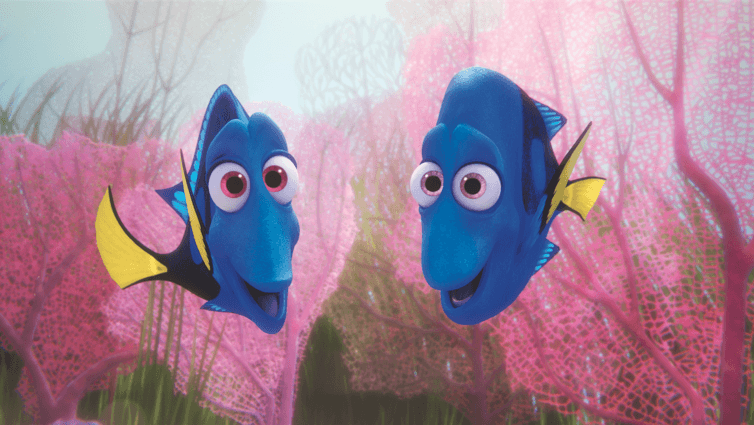
Cinema’s around the world are now showing Finding Dory, the long awaited sequel to Disney and Pixar’s 2003 Finding Nemo. The film takes up the story of Dory, a much loved character from the first film, who embarks on a quest to be reunited with her family. We follow the animated blue tang as she leaps and flip flops from one watery environment to the next, apparently happy to be transported in a beaker of drinking water, a mop bucket or through connecting pipes in a public aquarium.
Along the way, Dory – who suffers from short term memory loss – manages to regain some of the lost memories of her past life with assistance from Nemo, his father Marlin and an octopus named Hank.
In the run-up to the film’s opening in America, Finding Dory attracted media attention when questions were raised by conservationists, marine biologists and animal advocates about the potential for the film to trigger a craze for blue tang fish. The majority of marine aquarium species are still taken from the wild and, in the case of blue tang, the process of capture is harmful to both the fish and to coral reefs.
Finding Nemo led to a rapid growth in the trade of clownfish as pets which, in turn, contributed to the decline of wild populations. Reports suggested that the pet industry was expecting a similar growth in sales of blue tang and pet products following the release of Finding Dory.

Green entertainment
One response to concerns about the impacts of wild capture has been to initiate research into captive breeding programmes. For example, until very recently it was not thought possible to breed blue tang in captivity. But in late July 2016, an announcement from Rising Tide Conservation and University of Florida revealed that for the first time, blue tang had been successfully reared in captivity for 52 days. The press release noted that the six-year project to find an alternative to taking fish from the wild had backing from the SeaWorld-Busch Gardens Conservation Fund.
Many will recall that SeaWorld’s profits and public image were irreparably damaged by the 2013 documentary film Blackfish; a story about an orca named Tilikum. SeaWorld’s investment in the Rising Tide initiative and involvement in the captive breeding of blue tang may be playing a role in the company’s efforts to rebrand itself as a conservation organisation rather than an entertainment corporation and theme park.
In this respect it is some years behind Disney, the company responsible for Finding Dory, under its subsidiary brand Pixar. Disney’s moves to reorient the brand’s green credentials involved the creation of DisneyNature in 2008, a semi-autonomous film unit dedicated to producing nature documentaries, which are usually slated for release on Earth Day, and a revised corporate sustainability strategy.
Disney’s efforts have been branded by some in the press as greenwashing. My own analysis of the release strategy of DisneyNature films is in accordance with this: the tensions between the company’s commitment to what it calls “environmentality”, its green rebranding and its drive for profits are untenable.
For example, under pressure to address concerns about the impact of Finding Dory on blue tang, Disney Pixar released a downloadable guide to pet fish ownership. The guide is, however, difficult to find and the message that blue tang are not suited to life as a pet is completely overshadowed by the Disney marketing for the film and associated merchandise.
‘Baby Dory’
Indeed, the messages reaching the public about blue tang are worrying. Media coverage of the breakthrough in raising this fish in captivity, even referring to them as “baby Dory”, celebrates the technological solution that will allow consumers to purchase a sustainable Dory. Consumer fears that they are contributing to destruction of blue tang populations and coral reef areas are appeased by the message that it’s business as usual in the pet trade when entertainment, science and commerce work together.
The fact that many blue tang had to die in the process of developing a captive bred fish, that blue tang are still unsuitable as pets, that once in captivity and even under good conditions their lifespans are shortened, and that far from being the cute memory-challenged character we see onscreen, blue tang have spines on their tails designed to inflict injuries on would-be attackers – all this is lost in the celebratory communication that sustainable Dorys are on their way.
While we have yet to see if Finding Dory will have an impact on the trade in blue tang, the question over what degree of responsibility media companies should take for their representations of animals and their involvement in the promotion of animals as entertainment and pets remains. It has been surprisingly easy for media companies to continue to hide behind a thin veneer of greenwashing.
![]()
This article was originally published on The Conversation. Read the original article.
